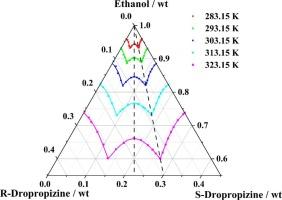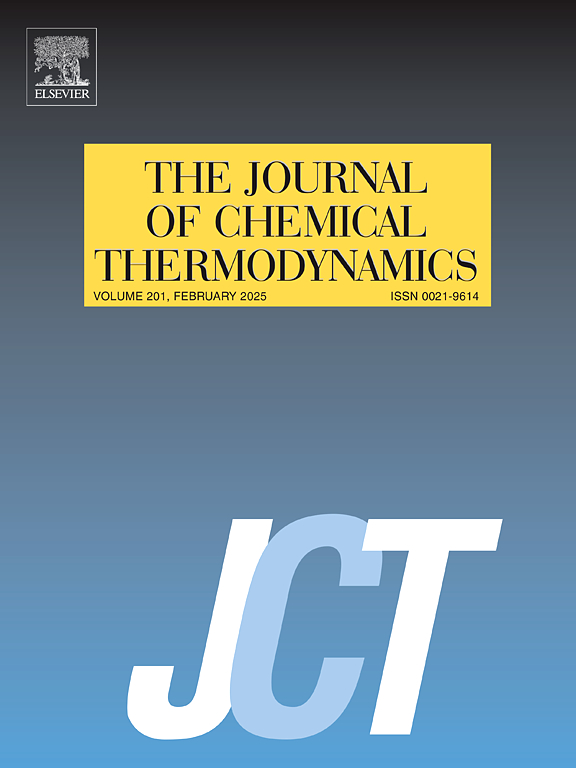Solubility study and molecular simulation of (S)- and (R,S)-dropropizine in seven single solvents
IF 2.2
3区 工程技术
Q3 CHEMISTRY, PHYSICAL
引用次数: 0
Abstract
The solubility of (S)- and (R,S)-dropropizine in seven single solvents at 283.15–323.15 K was investigated by the static method, and the relevance of the experimental solubility data was evaluated through three thermodynamic models (λh, Apelblat and Yaws formulas). All thermodynamic models had a good fit and ARD% values were all less than 3 %. The solubility of (S)- and (R,S)-dropropizine in the chosen solvents increased as the temperature rose. Then the solvent effect on solubility was elucidated by the KAT-LSER model. Furthermore, the solvation free energy of solutes in the selected solvents was simulated to investigate the solute-solvent interactions. In addition, the crystal structure of (S)- and (R,S)-dropropizine was predicted using the PXRD patterns. The unit cells of (S)- and (R,S)-dropropizine belonged to the monoclinic and triclinic systems, respectively. The analysis of intermolecular interactions was conducted using Hirshfeld surface analysis. Ultimately, the solubility isotherm ternary phase diagram in ethanol further identified that (R,S)-dropropizine was a racemic compound. This finding of this study will offer theoretical support to the pharmaceutical industry for better understanding the crystallization resolution of this chiral system.

(S)-和(R,S)-丙哌嗪在七种单一溶剂中的溶解度研究及分子模拟
采用静态方法研究了(S)-和(R,S)-dropropizine在283.15 ~ 323.15 K的7种单一溶剂中的溶解度,并通过3种热力学模型(λh、Apelblat和Yaws公式)评价了实验溶解度数据的相关性。所有热力学模型拟合良好,ARD%值均小于3%。(S)-和(R,S)-丙哌嗪在溶剂中的溶解度随温度升高而升高。然后用KAT-LSER模型分析了溶剂对溶解度的影响。此外,通过模拟溶剂中溶质的溶剂化自由能来研究溶质-溶剂的相互作用。此外,利用PXRD谱图预测了(S)-和(R,S)-丙丙哌嗪的晶体结构。(S)-和(R,S)-丙丙哌嗪的单位细胞分别属于单斜晶系和三斜晶系。分子间相互作用的分析采用赫希菲尔德表面分析法。最终,在乙醇中的溶解度等温三元相图进一步确定(R,S)-丙丙哌嗪为外消旋化合物。本研究的发现将为制药行业更好地了解该手性体系的结晶分辨率提供理论支持。
本文章由计算机程序翻译,如有差异,请以英文原文为准。
求助全文
约1分钟内获得全文
求助全文
来源期刊

Journal of Chemical Thermodynamics
工程技术-热力学
CiteScore
5.60
自引率
15.40%
发文量
199
审稿时长
79 days
期刊介绍:
The Journal of Chemical Thermodynamics exists primarily for dissemination of significant new knowledge in experimental equilibrium thermodynamics and transport properties of chemical systems. The defining attributes of The Journal are the quality and relevance of the papers published.
The Journal publishes work relating to gases, liquids, solids, polymers, mixtures, solutions and interfaces. Studies on systems with variability, such as biological or bio-based materials, gas hydrates, among others, will also be considered provided these are well characterized and reproducible where possible. Experimental methods should be described in sufficient detail to allow critical assessment of the accuracy claimed.
Authors are encouraged to provide physical or chemical interpretations of the results. Articles can contain modelling sections providing representations of data or molecular insights into the properties or transformations studied. Theoretical papers on chemical thermodynamics using molecular theory or modelling are also considered.
The Journal welcomes review articles in the field of chemical thermodynamics but prospective authors should first consult one of the Editors concerning the suitability of the proposed review.
Contributions of a routine nature or reporting on uncharacterised materials are not accepted.
 求助内容:
求助内容: 应助结果提醒方式:
应助结果提醒方式:


